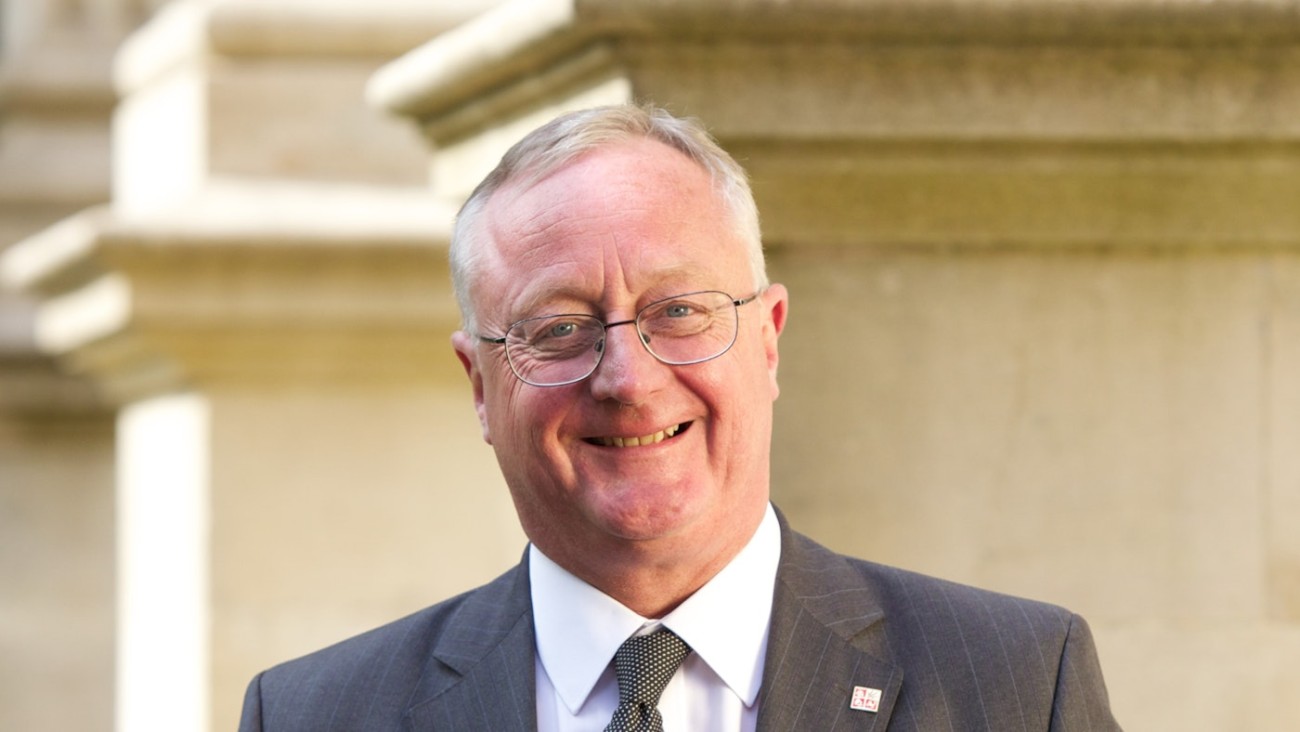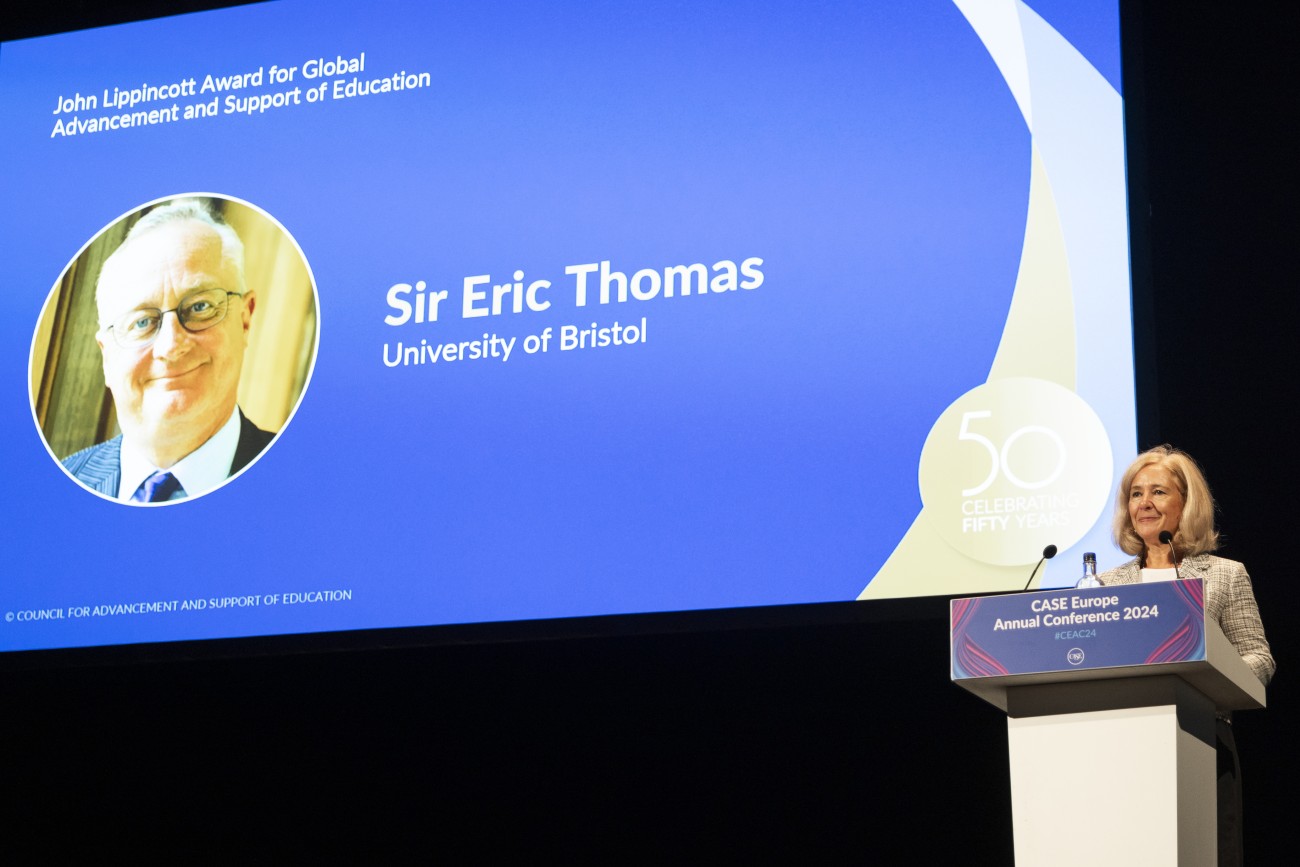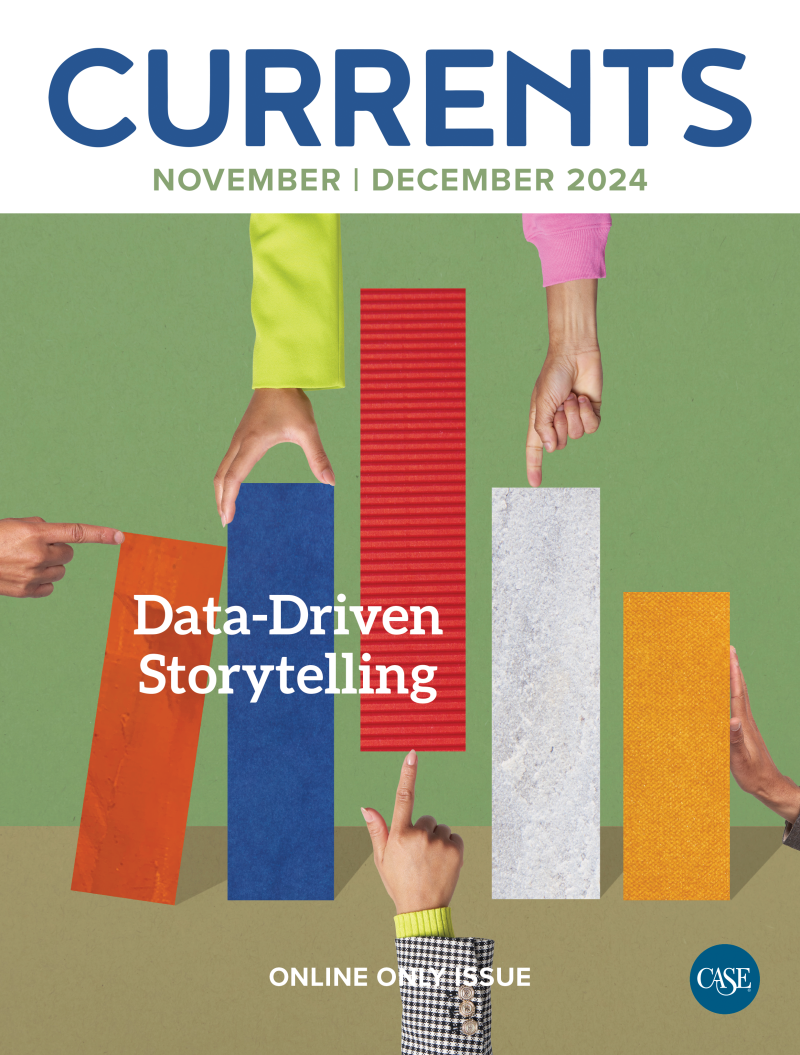
Two Decades of U.K. Higher Education Philanthropy
In the April 2005 edition of Currents magazine, Adrian Beney wrote an essay titled “British Advancement Comes of Age: The Thomas Report Aims to Cultivate a Culture of Asking.” The Thomas Report, formally known as Increasing Voluntary Giving to Higher Education, had just been released in March 2004 by Higher Education Funding Council for England. Beney, who was Deputy Director of Development and Alumni Relations at the University of Durham, England, at the time, wrote that the new report “is a sign of the seriousness with which the country’s leaders now treat the issue. It marks the modern coming of age for our profession in the U.K.”
Now, 20 years after publication of the Thomas Report, we invited Beney to return as an author to reflect on the last two decades, and the current landscape, of higher education philanthropy in the U.K.
Many families who love a hike outdoors will have stories of trying to cajole small children up a steep slope to get to the top. To the child the slope is steep and insurmountable. One way of encouraging the children is to tell them not to look back until the top of the next ridge. Then, standing proud, they can turn around to see how far they’ve come.
At the CASE Europe Annual Conference this year, attendees did something rather similar as they honoured the life of Professor Sir Eric Thomas, the posthumous winner of CASE’s John Lippincott Award for Global Advancement and Support of Education. Sir Eric, a former Vice-Chancellor of the University of Bristol, England, died last year.
Twenty years ago, in 2004, the British government asked Sir Eric to gather a Taskforce to consider what could be done to accelerate substantially the growing success in philanthropy being experienced by the United Kingdom’s higher education sector. The result was a report called Increasing Voluntary Giving to Higher Education. But mostly, people just referred to it as the Thomas Report. It became a vital foundation and reference book for growth.

SIR ERIC THOMAS
Former Vice-Chancellor of the University of Bristol
Highlights of the Thomas Report
The report had little time for whining that not enough people gave, and focussed instead on championing the importance of asking for support, which tied in with institutional mission and purpose.
The Report contained 11 recommendations. It’s instructive to pause on that high ridge and look back down to them today.
- Three recommendations related to tax relief on giving in the U.K. (In many ways this was already more generous than in the United States, since in the U.K. the only limit on tax relief for eligible gifts is the total tax a donor has paid in that year. But the structure is cumbersome and the scope of gifts somewhat limited.)
- Three related to public perception and celebration of philanthropy. Perhaps the most radical of these was the introduction of a scheme to match a university’s own investment in advancement, to be followed by a government scheme which actually matched donations. Each of these schemes encouraged universities to be bolder in the ways they invested in asking.
- One recommendation called for consistency and openness about how much money is raised and received. I think Sir Eric would be pleased with how the Ross-CASE Survey—now CASE Insights on Philanthropy (U.K. and Ireland)—has developed. Maybe he would prod his fellow vice-chancellors a bit, though, and challenge them to have their data as openly available as it is in the United States via the CASE Insights on Voluntary Support of Education.
- The remaining four—the largest single group of recommendations—were contained in a chapter called “Creating an Asking Institution” and concerned university leadership. In the U.K. and Ireland, this remains probably the single most important factor in the success, or otherwise, of philanthropic fundraising for education.
The Thomas Report was published during a golden era for British higher education. The banking crisis was yet to happen, and the rapid expansion of domestic student numbers was going to be the nation’s passport to a socially mobile, highly educated, high-tech economy. One of the U.K. higher education system’s biggest exports was the concept of fee income from international students, many of whom stayed on, attracted by the U.K.’s liberal democracy and mostly relaxed attitude to immigration.
Two Decades Later
How times have changed. The university funding model in England is now widely agreed to be broken. (Fee regimes are different in the other three countries of the United Kingdom: Scotland, Wales, and Northern Ireland. Each have a balance between the student and the state which is different from the English model. However, universities in all four nations of the UK face significant funding challenges.) Domestic undergraduate tuition in England is now funded by a fee/loan scheme which may have marginally increased social mobility, but has also resulted in record student debt, while the call on student support funds (some funded by philanthropy) has never been higher. Despite this, the fee that universities are permitted to charge has been frozen since 2017 and, on average, each domestic student is losing their university between £1,500 and £3,000 every year.
Until recently, the loss on domestic tuition had been subsidised by further expansion of the profitable overseas student market, especially from Asia and Africa. But populist concerns about immigration have made foreign student numbers a political touchpaper, with the right-wing, anti‑immigration Reform Party making a big impact in the July 2024 general election. Recent governments (and we’ve had a few since 2017) have tightened visa requirements. The flow of valuable foreign students has been tightly squeezed—so much so that around 40% of U.K. universities are running budget deficits.
Meanwhile we are growing a young generation of domestic alumni, now rising into their 30s, many of whom owe more than £100,000 repaid by a 9% salary deduction. What will be the future of alumni giving in this context? Rachel Brown, Head of Development and Alumni Relations at the University of Plymouth, England, notes that this has fostered more of a transactional relationship between students and universities. She asks, “Will they view their universities as worthy of further investment? We hope so.”
To say that this is a tough time for the leaders of the U.K.’s university sector is an understatement, and even the new Labour government has said it is not in favour of bailouts for universities that hit the skids.
So, it’s perhaps no surprise that leadership focus on fundraising is very mixed at present. Yet we know that long-term attention from a university’s senior management is critical to, and results in, fundraising success.
What a Recent Report Tells Us
This was a key theme in Accelerating Ambitions, the CASE-More report of 2023, based on interviews, research, a workforce survey, and many years of CASE Insights data. The Report found that universities that prize behaviours and attitudes sympathetic to successful fundraising continue to raise significant philanthropic income from donors large and small.
Typically, these universities have a track record of using donations well, with significant impact for the university and satisfaction for the donor. There is wide understanding and awareness of philanthropy’s importance and impact in the institution—it’s in its DNA. Senior staff—academics and administrators—believe that philanthropy is part of their jobs, and donors are integrated into the life of the university, referring to the university as “us” not “you.” And the advancement team has (almost) all the resources it needs to match the expectations it has been set. Of course, that’s the dream and no institution scores a perfect ten on all those qualities. But they are the qualities that make success likely, and while all of these are not solely the responsibility of the vice-chancellor, the vice-chancellor does set the tone and leads from the front on all of them. Brown notes that “achieving the transformational income we all aspire to requires the long view from our senior teams.”
Some British universities have taken up this leadership challenge so eloquently set out by the Thomas Report. They have invested in advancement teams with tremendous success, seeing performance whose return on investment rivals the best in the United States. Small institutions like the Royal Academy of Music and the Royal College of Art (both in London, England) as well as large, multi-faculty, research-intensive universities like University College London and Ireland’s Trinity College Dublin have completed successful campaigns with gifts that have transformed the institutions. The Universities of Oxford and Cambridge (both public universities) have, for many years, shown consistent fundraising performance on a par with equivalent-sized private universities in the United States, according to CASE Insights data.
In the U.K. and Ireland, we have shown that universities on this side of the Atlantic can attract multimillion pound or euro gifts from at home and abroad. Some of these (especially gifts from China and the Persian Gulf) have attracted intense ethical and moral scrutiny, an uncomfortable place for many university leaders. While we have yet to see giving at the USD billion level, there have been gifts of more than USD $100 million. And alumni participation in a small number of universities rivals that of successful public universities in the United States.
But beyond the very successful, results are much less consistent. Two thirds of universities taking part in the CASE Insights on Philanthropy (U.K. and Ireland) survey have reported a gift of at least GBP 1 million since 2014, but a quarter have only done this once in that time. And investment in lower-level giving—annual or regular—is hard-pressed in many places. Many alumni are not asked to give at all and recently some universities have implemented significant cuts in advancement budgets.
Why? Because competition for an increasingly restricted market of students is the pressing issue for so many. This has a toll on both budgets and leadership attention for advancement. How can a vice-chancellor justify continued spending on development and alumni relations when academic departments are taking cuts, professors are teaching more students, and laboratory equipment is out of date? There are choices to be made, and it takes leadership from the top and confidence from the senior management in the advancement operation to not make cuts against this background.
The result is investment in advancement that ebbs and flows over time. For some, the tide is very low at present. Lead author of Accelerating Ambitions (The CASE-More Report) Joanna Motion, former CASE Vice President, International and now Associate with consulting firm More Partnership, has watched universities go through this ebb and flow more than once, with some closing advancement almost completely only to restart it some years later. She calls this frustrating situation a “serial start-up.”
Not all smaller shops have lost their nerve though. Dominic Boyd, Director of Development at Manchester Metropolitan University, England, says, “I think negative dismissive rhetoric is changing. A recent survey conducted by King’s College London actually confirmed that U.K. universities were highly regarded by the British public, coming only behind the National Health Service, the armed forces, and the royal family in a league table of U.K. institutions considered to be among the best in the world. This matters. Our universities are a fantastic U.K. success story and people instinctively understand this. The solutions to the world’s greatest challenges are likely to be found within universities; that’s an attractive proposition for philanthropists.”
Boyd continues, “My own vice-chancellor, Professor Malcolm Press CBE, is the most passionate champion for Manchester Metropolitan University you could imagine, but he combines this with an advocacy for all of higher education.”
Beyond pure philanthropy, James Johnston, until recently Head of Development and Alumni at Sheffield Hallam University, England, argues that there is an opportunity for universities to use the strategic relationship management skills of advancement with other external partners, more broadly than solely in philanthropy. This would “help grow funding and partnership, and future investment. It would require greater collaboration and alignment in university teams such as alumni relations, communications teams, business development, and careers services to ensure resource was aligned together to deliver growth,” says Johnston, who is Vice Chair of the U.K./Ireland CASE Cabinet.
Responding to Sir Eric’s Call
There is a wide variety of higher education institutions in the U.K. Twenty years on from Sir Eric’s report, there is an equally wide range of confidence in fundraising itself and in the idea that our universities are charities worthy of philanthropic support. But investment only comes where there is confidence. Oxford and Cambridge (including their colleges) have advancement staff cohorts which rival successful U.S. institutions, while 15 other universities have more than 50 staff (something almost unthinkable back in 2005). In these institutions, the leadership commitment to philanthropy is secure, as it is in some smaller shops like Manchester Metropolitan. But we still have small and vulnerable operations where expectation management, access to leadership for advancement staff, and institutional confidence are the difference between success and closure, and the whole operation is acutely sensitive to senior leadership change.
With this in mind, Motion developed the “Playbook” section of the Accelerating Ambitions report. It’s a short, practical guide for institutions at different stages of development that want to grow the impact of philanthropy in a way that is sustainable in the long term. There is advice for all, from the newest to the most advanced, which the authors hope will stand the test of time in the same way that the Thomas Report has done.
Few who work in higher education need persuading of the social, cultural, and economic imperative to educate our populations and carry out both fundamental and applied research. As former CASE Trustee Sue Washburn said, “Education is not in competition with all those other charitable causes, it’s the answer to most of them.” We have a noble calling.
I hope Sir Eric would be pleased with how the U.K. has responded to the call in his report to grow the resources needed to achieve our universities’ noble mission and purpose. There remains an urgent need for the kind of energy and commitment that he exemplified if we are to widen and deepen the impact of philanthropy in our institutions as the Thomas Report envisaged.
Remembering Sir Eric Thomas

CELEBRATING SIR ERIC THOMAS: CASE President and CEO Sue Cunningham speaks about Sir Eric Thomas at the 2024 CASE Europe Annual Conference.
Sir Eric Thomas, former Vice-Chancellor and President of the University of Bristol, U.K., passed away in November 2023. He was Bristol’s 12th Vice-Chancellor and led the university for 14 years between 2001 and 2015. During his time at Bristol, Thomas was President of Universities U.K. from 2011 to 2013, a founding member and President for four years of the Worldwide Universities Network, and he received a knighthood in the Queen’s Birthday Honours 2013 for services to higher education. Sir Eric was a dedicated CASE volunteer who chaired the CASE Europe Board of Trustees from 2010 to 2014. This past August, he was posthumously presented with the John Lippincott Award for Global Advancement and Support of Education at the CASE Europe Annual Conference.
He is remembered with high esteem:
“Eric was an inspiration to many in CASE’s global community and a dear friend to CASE. He played a critical role in the growth of professional educational advancement in the U.K. and supported our programmes in other parts of the world, including in Latin America. On a personal note, I feel so grateful to have known Eric. He demonstrated immense passion and dedication to CASE and our community—he truly understood the impact, joy, and transformational impact of educational advancement.” – Sue Cunningham, CASE President and CEO
“Eric Thomas’ untimely death deprives the CASE community of one of its stars. One of the many great pieces of advice he gave me was to get involved with CASE. The friends and contacts that I have made as a result of taking that advice have enriched my life, for that amongst other things, I will be forever grateful to him." – Sir Peter Mathieson, Principal of the University of Edinburgh, U.K., and former CASE Trustee
“Working with Eric was a privilege, pleasure, and challenge—all at once. He was true to his beliefs and principles. The Thomas Report and Eric’s subsequent philanthropy leadership were powerful because he always asked penetrating questions, always listened carefully and assimilated, always built his vast knowledge and understanding of the world. He was the best of friends in every way. What a huge loss for the sector.” – TJ Rawlinson, Director of Development and Alumni Relations at Cardiff University, U.K., who worked with Sir Eric for 11 years during his time as Vice-Chancellor of the University of Bristol (2001-2015)
“Sir Eric’s unwavering message was clear—for universities to fundraise for the benefit of their students and research was not only desirable, but essential. I am fortunate to be one of countless people to have been guided by Eric, particularly in his role as inaugural chair for the £300 million philanthropic campaign for Newcastle University. I know he was proud to have helped launch an initiative that will create countless opportunities for future generations. He will be greatly missed.” – Paul Tyack, Director of Advancement at the University of Newcastle, U.K., Sir Eric’s alma mater
At the 2024 CASE Europe Annual Conference, CASE celebrated Sir Eric Thomas, the posthumous winner of CASE’s John Lippincott Award for Global Advancement and Support of Education.
About the author(s)
Adrian Beney is a Partner at More Partnership and has been a fundraiser for more than 35 years. He established the Development and Alumni Office at the University of Durham, including programmes in Alumni Relations, Major Gifts, Regular Giving and more. When he left in 2005 Durham had one of the highest alumni participation rates in the UK, the result of innovative fundraising practice and integrated communications across fundraising and alumni relations activity.
With Rosie Dale he leads More’s award winning Regular Giving Insight and Benchmarking project which has analysed mass giving programmes and patterns over twenty years in around 60 universities and colleges in the UK, Ireland, Australia and the United States. The project now goes beyond data analysis and insight, providing segmentation advice, suggested KPIs and tags for each donor.
Adrian’s recent clients include Imperial College, the University of Leeds, Trinity College Dublin, Balliol College, Oxford and the National Trust for Scotland where the creation and implementation of Supporter Journeys to improve both income and return on investment are a priority. He has worked recently on GDPR related matters at Blue Cross and on strategy development with the Cathedral Music Trust.
He was the first European recipient of a CASE Crystal Apple, a member of its Philanthropy Commission, and a faculty member for the Spring Institute in Educational Fundraising. He received CASE Europe’s Distinguished Service Award in 2015. He was “trustee” of Durham Cathedral and is now a Canon of Tamale Cathedral in northern Ghana. He is a trustee of the Parish Giving Scheme, a payment services charity enabling over £60 million of giving by direct debit to thousands of Church of England parishes last year.
Tags
Article appears in:

November - December 2024
DIGITAL-ONLY ISSUE - Using data, visualizations, and infographics to reach donors and alumni.
Plus communications strategies for corporate relations professionals, the story behind one university's new alumni center, a look inside CASE's new Latin America benchmarking project, and more.
